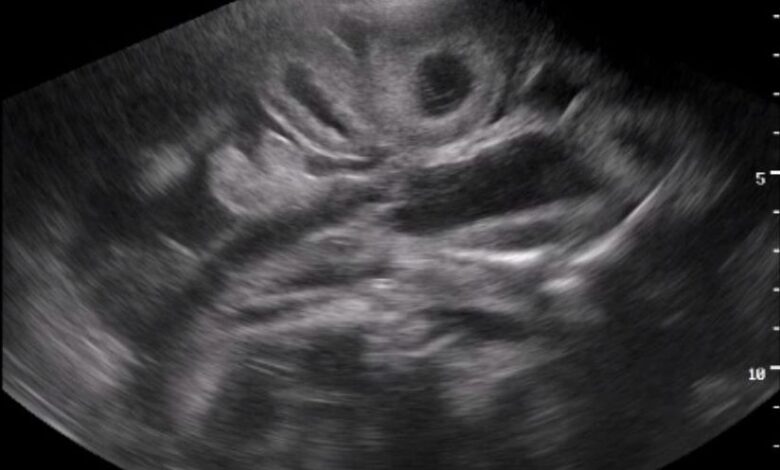
Important Techniques for Pregnancy Determination in Goats
1. Ultrasound Scanning
- Types: Transrectal (25–35 days), Transabdominal (after 30 days)
- What it detects: Embryo, fetal heartbeat, number of fetuses
- Advantages: High accuracy, detects early pregnancy and multiple fetuses
- Limitations: Requires equipment and trained personnel
2. Hormone Testing
a. Progesterone Test
- Timing: 18–21 days post-mating
- Sample: Blood or milk
- Use: High progesterone suggests pregnancy; low indicates non-pregnancy
- Limitation: Cannot confirm a viable fetus
b. Pregnancy-Associated Glycoproteins (PAGs)
- Timing: From 28–30 days post-breeding
- Sample: Blood or milk
- Advantage: Accurate, especially in early pregnancy
3. Abdominal Palpation
- Timing: After 3 months of gestation
- What is felt: Fetus or fluid in uterus
- Limitations: Requires experience; not useful for early diagnosis
4. Observation of Estrus Behavior
- Method: Monitor for signs of heat after breeding
- Timing: Watch for return to estrus at 18–21 days
- Note: Absence of heat may suggest pregnancy
- Limitation: Silent heats or irregular cycles can cause false assumptions
5. X-Ray Imaging
- Timing: After ~75 days of pregnancy
- What it shows: Fetal skeletons
- Use: Confirms pregnancy and fetal number in late gestation
- Limitation: Requires specialized equipment and handling
Summary in Table
| Technique | Timing | Accuracy | Equipment Needed |
|---|---|---|---|
| Ultrasound | 25–30+ days | High | Yes |
| PAG Blood/Milk Test | 28–30+ days | High | Moderate |
| Progesterone Test | 18–21 days | Moderate | Low |
| Palpation | >3 months | Moderate | No |
| Estrus Observation | 18–21 days | Low-Moderate | No |
| X-ray | >75 days | High | Yes |
Pregnancy determination in does is commonly performed using real-time ultrasonography to visualize the presence of an embryo/fetus and placentomes within the uterus. Transabdominal ultrasound is quick and reliable and can detect pregnancy as early as 30 days, though it is most accurate after 45 days gestation. If possible, does should be fasted from food (12 hours) and water (4 hours) to improve speed and accuracy when performing ultrasonography in large herds. Transrectal ultrasound is more difficult and time consuming although it can diagnose pregnancy as early as 20 days. Ultrasonography can be used to count embryos/fetuses most accurately up to 85 days gestation, which is important when managing does prone to pregnancy toxemia in late gestation. Fetal sexing may be performed by skilled ultrasonographers between days 55 and 70 of gestation and is more accurate in singles versus multiples. Radiography can be used to detect pregnancy with 100% accuracy after day 70 and can detect the number of kids after day 75, though is not routinely performed because of impracticality and cost.
Twin pregnancy, goat (ultrasonography)
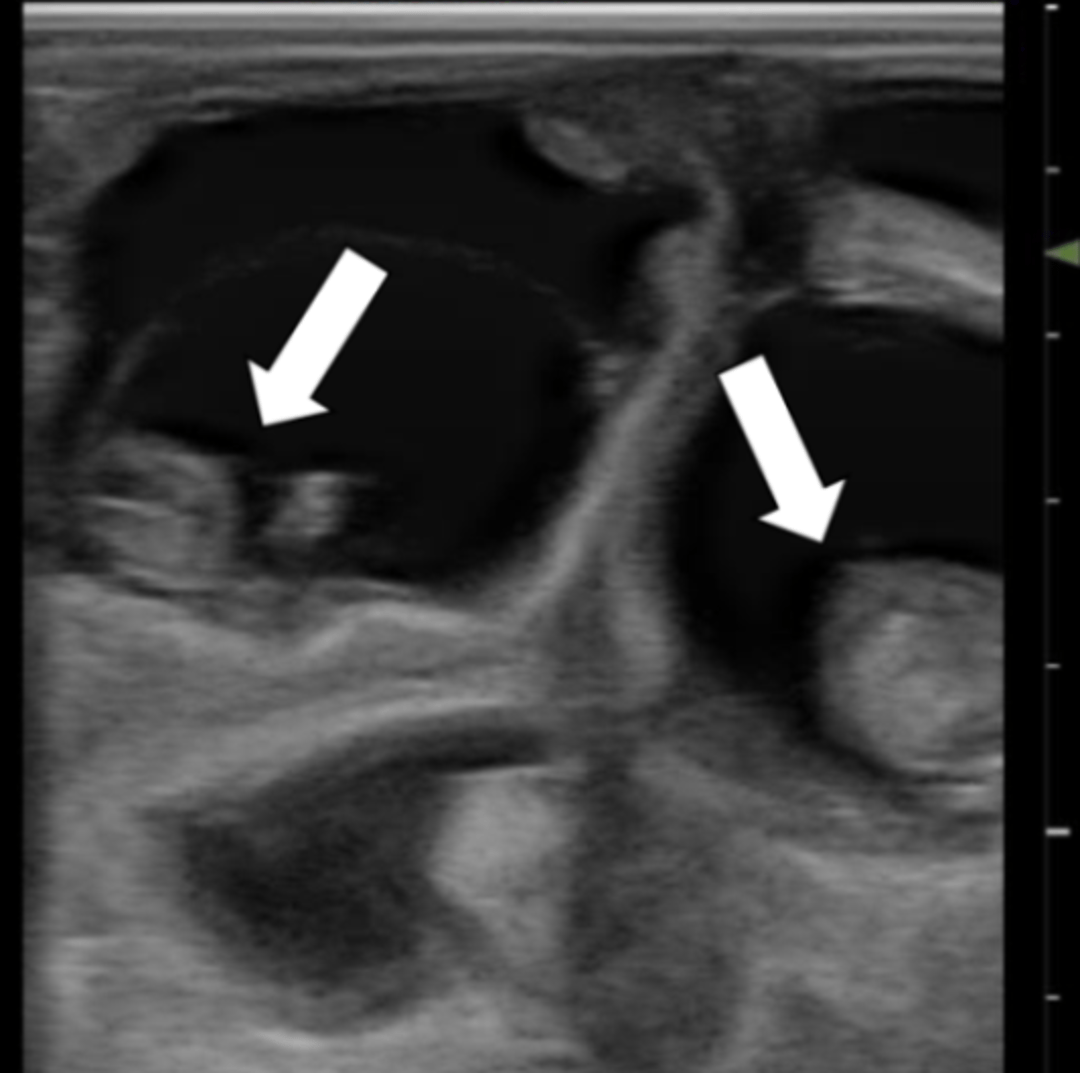
Progesterone concentrations can be measured in milk or serum. Samples must be collected precisely one cycle (19–24 days) after the doe is bred. Whereas low progesterone levels can confirm that a doe is not pregnant, high progesterone is not a positive pregnancy test, because it cannot differentiate between midcycle, true pregnancy, or pseudopregnancy. Additionally, progesterone concentrations cannot accurately determine viability or predict fetal number when performed early in pregnancy. However, if measured at >3 months gestation, progesterone concentrations have been reported to be higher in does bearing triplets then in does bearing twins or single fetuses.
The estrone sulfate test, performed on plasma or urine, is another method to determine pregnancy. Between 15 and 20 days after conception, the level of estrone sulfate, a conjugated estrogen produced by the conceptus, increases substantially and stays increased throughout pregnancy. Most commercial laboratories recommend waiting until 50–60 days gestation to test does to ensure accurate results. Higher concentrations of estrone sulfate have been reported in does carrying twins or triplets than in those bearing a single fetus. Abortion, fetal death, or embryonic resorption cause the estrone sulfate levels to drop; therefore, the test also is a useful measure of conceptus viability.
The estrone sulfate test, performed on plasma or urine, is another method to determine pregnancy. Between 15 and 20 days after conception, the level of estrone sulfate, a conjugated estrogen produced by the conceptus, increases substantially and stays increased throughout pregnancy. Most commercial laboratories recommend waiting until 50–60 days gestation to test does to ensure accurate results. Higher concentrations of estrone sulfate have been reported in does carrying twins or triplets than in those bearing a single fetus. Abortion, fetal death, or embryonic resorption cause the estrone sulfate levels to drop; therefore, the test also is a useful measure of conceptus viability.
Pregnancy-specific protein B (PSPB), also known as pregnancy-associated glycoprotein, is produced by the placenta and can be detected in serum or plasma of pregnant does via ELISA at least 25–30 days after breeding. Owners may choose to submit this test themselves after observing nonreturn to estrus in bred does. Concentrations of PSPB are reportedly lower in does carrying singletons versus multiples. Therefore, grouping does by PSPB levels may be useful when managing does in late gestation. However, because of the long half-life of PSPB, false positives may occur when fetal death has occurred within the last 15 days.
Hydrometra, or pseudopregnancy,

It is well documented in goats, although its cause is largely unknown. Aseptic fluid accumulates within the uterus and is accompanied by high peripheral concentrations of progesterone due to a failure of luteolysis. Approximately 50% of pseudopregnancies may result from early embryonic death at ≤40 days of gestation.
Hydrometra can be treated with prostaglandin to lyse the corpus luteum, and does may be able to conceive again if diagnosed and treated early. However, if the condition persists or recurs, the chances of future conception decline, and does should be culled. Other reported causes of hydrometra in older does include cervical adhesions that develop after a dystocia and that prevent normal drainage of fluid or neoplasia. These animals will not respond to prostaglandin administration and have a poor prognosis for fertility.
Prevention of abortions and prevention of infertility are best achieved by maintaining low stress herds and implementing appropriate biosecurity measures. New animals should be isolated for 2–3 weeks before introducing them to the herd. Vaccinations against Chlamydia and Campylobacter spp may be incorporated into herd health protocols if necessary. However, these vaccinations only minimize losses and do not completely prevent infections. Though previous strategies to reduce likelihood of abortions involved the prophylactic administration of feed-grade tetracyclines, this practice had minimal efficacy and is now restricted with the implementation of the veterinary feed directive.
Pregnancy Determination in Goats FAQs
1. How soon can I tell if a goat is pregnant?
➡️ As early as 25–30 days using ultrasound or blood tests.
2. What is the easiest method for pregnancy detection?
➡️ Blood or milk PAG tests are easy and accurate.
3. Can I just watch for signs of heat?
➡️ Yes, but it’s not always reliable—some pregnant does may show heat-like behavior.
4. Is ultrasound safe for goats?
➡️ Yes, it’s safe and non-invasive.
5. Can I feel the fetus by hand?
➡️ Only after 3 months, and it requires experience.
6. How accurate is progesterone testing?
➡️ It helps rule out pregnancy, but can’t confirm a live fetus.
7. Can X-rays be used?
➡️ Yes, after 75 days, but not commonly used due to equipment needs.
Need Veterinary Help?
If you have questions about animal health, management, diseases, or treatment, we’re here to help! Our professional veterinary team is ready to assist you with reliable guidance and support.
📞 Consult Online: Contact Us
📧 Email: professionaldvm129@gmail.com
🌐 Visit: www.veterinaryhub.info

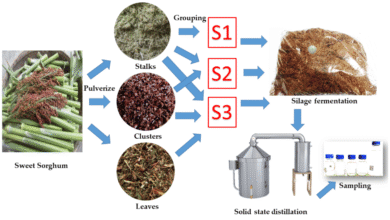

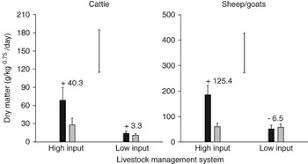


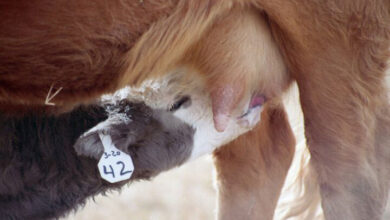
zdjlz6